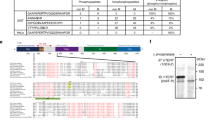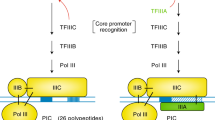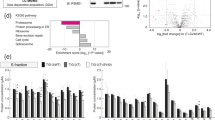Abstract
The human TEL gene is involved in several 12p13 chromosomal abnormalities present in various human hematological malignancies, the most frequent being the t(12;21)(p13;q22), specific for childhood acute lymphoblastic leukemia. The predicted product of TEL harbours an amino acid region similar to the ETS DNA binding domain. We now report the isolation of the murine TEL cDNA and the characterization of the human TEL proteins. Human and murine TEL proteins are particularly homologous within their aminoterminal regions and their ETS domains. TEL proteins are nuclear and display specific DNA binding activity toward classical ETS binding sites. In addition, we show that TEL mRNAs initiate translation at either of the two first in-frame ATGs (codon 1 and 43) to encode 50 kDa and 57 kDa TEL proteins. In vivo, each of these primary translational products is modified by multiple phosphorylation events.
This is a preview of subscription content, access via your institution
Access options
Subscribe to this journal
Receive 50 print issues and online access
$259.00 per year
only $5.18 per issue
Buy this article
- Purchase on Springer Link
- Instant access to full article PDF
Prices may be subject to local taxes which are calculated during checkout
Similar content being viewed by others
Author information
Authors and Affiliations
Rights and permissions
About this article
Cite this article
Poirel, H., Oury, C., Carron, C. et al. The TEL gene products: nuclear phosphoproteins with DNA binding properties. Oncogene 14, 349–357 (1997). https://doi.org/10.1038/sj.onc.1200829
Received:
Revised:
Accepted:
Issue Date:
DOI: https://doi.org/10.1038/sj.onc.1200829
Keywords
This article is cited by
-
ETV6 dependency in Ewing sarcoma by antagonism of EWS-FLI1-mediated enhancer activation
Nature Cell Biology (2023)
-
Detection of ETV6 gene rearrangements in adult acute lymphoblastic leukemia
Annals of Hematology (2012)
-
Incidence of additional genetic changes in the TEL and AML1 genes in DCOG and COALL-treated t(12;21)-positive pediatric ALL, and their relation with drug sensitivity and clinical outcome
Leukemia (2006)
-
Functional analyses of the TEL-ARNT fusion protein underscores a role for oxygen tension in hematopoietic cellular differentiation
Oncogene (2006)
-
Somatic heterozygous mutations in ETV6 (TEL) and frequent absence of ETV6 protein in acute myeloid leukemia
Oncogene (2005)



